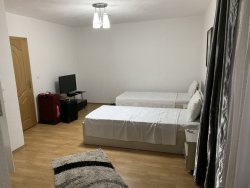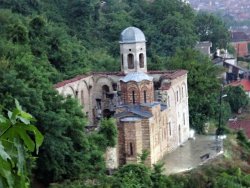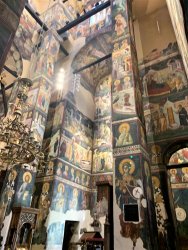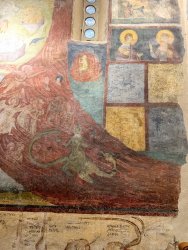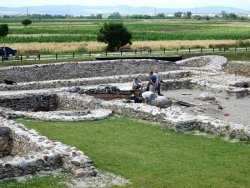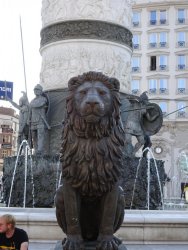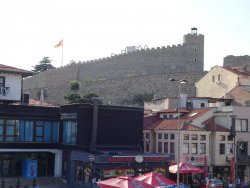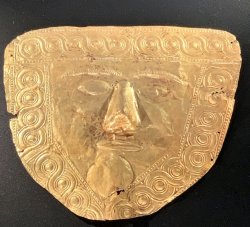- Joined
- Nov 12, 2012
- Posts
- 31,093
- Qantas
- Platinum
- Virgin
- Platinum
- Star Alliance
- Gold
We were up on the flanks of the Sar mountains, which host Macedonia's 2 highest peaks, at 2764 and 2745m. We had to climb through these to get to Kosovo, and the weather finally failed us (for the first and only time on the trip):
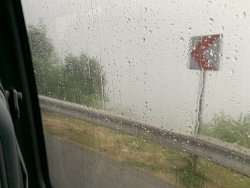
I'm happy to say that I got a Kosovo stamp in my passport .. but the Brits didn't. Stamps were a continuously inconsistent thing on this trip. In Macedonia, some Brits go a stamp on entry and/or exit, others didn't. I usually got a stamp, but 2 out of 8 entries/exits, I didn't.
Reason I'm happy with the Kosovo stamp is that I reckon the country won't be in existence for a long time. This is the Readers Digest version ... details will (and have) filled books ...
Kosovo became part of the Serbian empire in the early 1300s. It was part of the Ottoman empire from 1455 to 1912, when Islam was introduced and, unlike Macedonia etc, it became the dominant religion. Albanians accepted the Ottomans and converted to Islam en-mass. The Albanians and Serbs came into conflict in the late 1800s and Albanians in Serbia were expelled into ares now generally within Kosovo.
The Albanians effectively expelled the Turks in 1912 as did the Serbs, Greeks, Montenegrans and Bulgarians. Kosovo ended up with Serbia.
After the Axis invasion in WW2, Kosovo was assigned to Italian-controlled Albania. Many Serbs were killed in Kosovo and many more fled east to Serbia proper. On the creation of Yugoslavia, Kosovo was assigned to Serbia as an autonomous region, but much tension between the ethnic Albanians in Kosovo and the Serbs. A separatist movement arose in the 1980s. Violence after government suppression ensued, and the % of Albanians vs Serbs had increased due to differing birth rates and continued leaving by Serbs from the area.
In 1989, Serbian President Slobodan Milošević, tried to reduce Kosovo's autonomy which had the predicable result of increasing the separatist movement, protests etc. The Kosovo Liberation Army came into being in the 1990s and a state of warfare ensued, with many massacres on both sides; a ceasefire forced internationally in 1998. it didn't last and in the end NATO bombed Yugoslavia to force the issue. Milošević and others were tried for war crimes during the conflict.
A few years of confusion followed, with the nature of Kosovo's independence debated in the UN, with Russia vetoing the outright recognition of Kosovo, as long as Serbia didn't like it. Kosovo declared unilateral independence in 2008 and currently is recognised by 112 countries, including all its neighbours, except Serbia (also recognised by Australia). It belongs to many world institutions, but not the UN and uses the Euro as its currency.
Interestingly, the most common flag you see is the Albanian flag - including at the border crossings. That's why I reckon Kosovo will eventually become part of Albania .. ethnically, religiously and historically, that's where it belongs; but whether Serbia and its allies will ever allow that, is another question.

I'm happy to say that I got a Kosovo stamp in my passport .. but the Brits didn't. Stamps were a continuously inconsistent thing on this trip. In Macedonia, some Brits go a stamp on entry and/or exit, others didn't. I usually got a stamp, but 2 out of 8 entries/exits, I didn't.
Reason I'm happy with the Kosovo stamp is that I reckon the country won't be in existence for a long time. This is the Readers Digest version ... details will (and have) filled books ...
Kosovo became part of the Serbian empire in the early 1300s. It was part of the Ottoman empire from 1455 to 1912, when Islam was introduced and, unlike Macedonia etc, it became the dominant religion. Albanians accepted the Ottomans and converted to Islam en-mass. The Albanians and Serbs came into conflict in the late 1800s and Albanians in Serbia were expelled into ares now generally within Kosovo.
The Albanians effectively expelled the Turks in 1912 as did the Serbs, Greeks, Montenegrans and Bulgarians. Kosovo ended up with Serbia.
After the Axis invasion in WW2, Kosovo was assigned to Italian-controlled Albania. Many Serbs were killed in Kosovo and many more fled east to Serbia proper. On the creation of Yugoslavia, Kosovo was assigned to Serbia as an autonomous region, but much tension between the ethnic Albanians in Kosovo and the Serbs. A separatist movement arose in the 1980s. Violence after government suppression ensued, and the % of Albanians vs Serbs had increased due to differing birth rates and continued leaving by Serbs from the area.
In 1989, Serbian President Slobodan Milošević, tried to reduce Kosovo's autonomy which had the predicable result of increasing the separatist movement, protests etc. The Kosovo Liberation Army came into being in the 1990s and a state of warfare ensued, with many massacres on both sides; a ceasefire forced internationally in 1998. it didn't last and in the end NATO bombed Yugoslavia to force the issue. Milošević and others were tried for war crimes during the conflict.
A few years of confusion followed, with the nature of Kosovo's independence debated in the UN, with Russia vetoing the outright recognition of Kosovo, as long as Serbia didn't like it. Kosovo declared unilateral independence in 2008 and currently is recognised by 112 countries, including all its neighbours, except Serbia (also recognised by Australia). It belongs to many world institutions, but not the UN and uses the Euro as its currency.
Interestingly, the most common flag you see is the Albanian flag - including at the border crossings. That's why I reckon Kosovo will eventually become part of Albania .. ethnically, religiously and historically, that's where it belongs; but whether Serbia and its allies will ever allow that, is another question.







